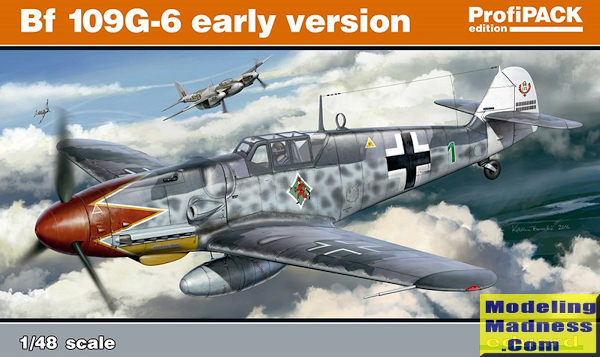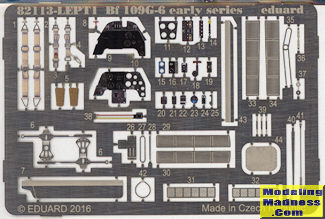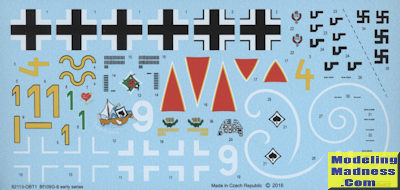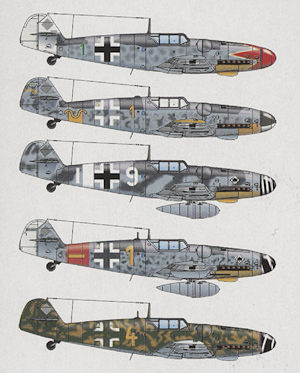
| KIT #: | 82113 |
| PRICE: | $36.49 on line ($49.95 SRP) |
| DECALS: | Five options |
| REVIEWER: | Scott Van Aken |
| NOTES: | Profipack. 2016 boxing |

| HISTORY |
Ask someone who knows a little about WWII aircraft what was the most important German plane of WWII and they will probably say the Me-109. They'd be right as, like the Spitfire, it was in production from day one until the end. As with all long-lived aircraft, the airframe was constantly modified until the last of the 109 series held little that was interchangeable with the first.
By far, the greatest number of 109s produced was the G series and the most produced of the G series was the G-6. This variant was built for around two years (a very long time in the early/mid 1940s) but was modified as time went on and the situation changed. Not surprisingly, many of the late war Luftwaffe aces flew this version at some time during their career.
| THE KIT |
 Last
year, after a lot of anticipation and an equal amount of hype, Eduard released
what was to be the best 1/48 Bf-109 every kitted. To quote a line from 'The
Right Stuff', they screwed the pooch. It turned out that the aircraft was not
1/48 scale with parts of it in different scales. It built nicely, but when one
promises the world and then doesn't deliver, it causes much anguish amongst the
faithful.
Last
year, after a lot of anticipation and an equal amount of hype, Eduard released
what was to be the best 1/48 Bf-109 every kitted. To quote a line from 'The
Right Stuff', they screwed the pooch. It turned out that the aircraft was not
1/48 scale with parts of it in different scales. It built nicely, but when one
promises the world and then doesn't deliver, it causes much anguish amongst the
faithful.
How the situation came to be doesn't matter, only that it happened. To Eduard's credit, they did not just say 'oh well' and continue cranking out different variations on that flawed kit. Instead, I've been led to believe that they completely retooled the kit to eradicate the flaws and give those who are so passionate about their 109s a proper kit. This is the result of that.
One first notices that there are a lot of parts. Eduard is one
of those companies who basically runs a myriad of variants from a basic tooling.
It is the smart way to do kits in today's market, especially a subject like the
109 which was built in a bewildering number of sub-variations through its
production life. None more varied that the 109G. This kit is touted as an 'early'
version and what that means to most modelers is that all the markings options
are for aircraft that use the early canopy and the short, standard rudder.
The plastic in this kit is exactly the same as in the 'late' boxing and I'm
betting that those who want to do the later version with this kit will be able
to do so with minimal work. I am also betting that most of these sprues are used
for the new 109F kit.

I say that as the photo etch is not identical. The set for this kit differs in having the lower fuselage hatch and does not have a few smaller bits that fit in that location on the fret. This fret includes belts, instruments, radiator screens, exhaust shield, rudder pedals, and a number of other smaller bits. In addition to the p.e. fret, you get canopy and wheel masks (these mask the hubs).
The cockpit is nicely done and one will have to do some cutting and drilling to use all the etched bits. All the control surfaces are separate bits, including the flaps and slats and radiator exhaust flaps. For things on the underside, you have a drop tank and the option of the lower wing cannon if you so desire to use those.
 I
I nstructions
are quite comprehensive and provide detailed information on what bits to use,
what holes to open, what areas to fill and so on depending on the markings
option you are modeling. This means that you'll need to make that decision
rather early. Four of the five options are in standard RLM 74/75/76 with various
degrees of mottling. It is not surprising that you get some 'done to death'
markings, but that's commerce for you. The first is Hermann Graf's plane when he
was with JGr 50 in late 1943. Next is one of Erich Hartmann's planes from JG 52
in October of 1943. White 9 is Georg Amon's plane from JG 53 in Sicily during
June 1943. Yellow 1 is Alfred Hammer's plane with JG 53 back in Germany during
February 1944 while on Reich defense duty. The lone non-standard paint scheme is
Rene Darbois of JG 4 in Italy during July 1944. This one is painted in Italian
colors on the upper surface consisting of Verde Oliva Scurio 2 and Nocciola
Chiaro 4. Decals are well done and you get complete swastikas (at least in the
US market).
nstructions
are quite comprehensive and provide detailed information on what bits to use,
what holes to open, what areas to fill and so on depending on the markings
option you are modeling. This means that you'll need to make that decision
rather early. Four of the five options are in standard RLM 74/75/76 with various
degrees of mottling. It is not surprising that you get some 'done to death'
markings, but that's commerce for you. The first is Hermann Graf's plane when he
was with JGr 50 in late 1943. Next is one of Erich Hartmann's planes from JG 52
in October of 1943. White 9 is Georg Amon's plane from JG 53 in Sicily during
June 1943. Yellow 1 is Alfred Hammer's plane with JG 53 back in Germany during
February 1944 while on Reich defense duty. The lone non-standard paint scheme is
Rene Darbois of JG 4 in Italy during July 1944. This one is painted in Italian
colors on the upper surface consisting of Verde Oliva Scurio 2 and Nocciola
Chiaro 4. Decals are well done and you get complete swastikas (at least in the
US market).
| CONCLUSIONS |
I am looking forward to building one of these 109Gs so I can see if it is as fiddly as their E variants. I am hoping it isn't the case and while I have a ton of Hasegawa 109Gs, it couldn't hurt to have just one more, could it?
November 2016
Copyright ModelingMadness.com. All rights reserved.
Thanks to me for the preview kit.
If you would like your product reviewed fairly and fairly quickly, please contact the editor or see other details in the Note to Contributors.